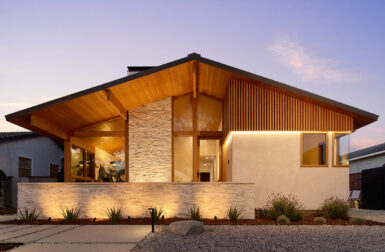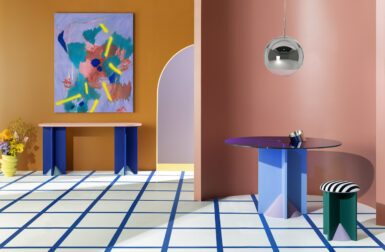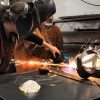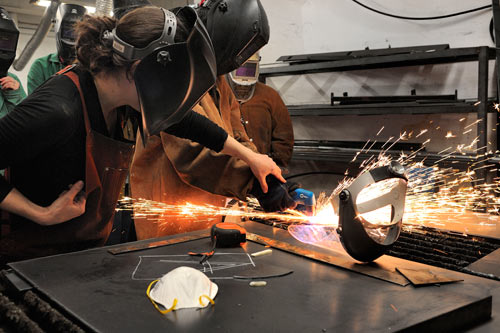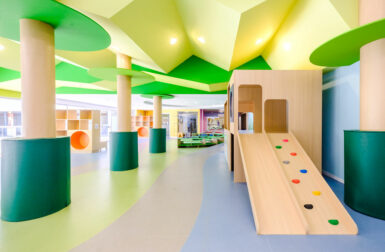Parsons The New School for Design, located in New York City, is made up of five schools that bring together graduate and undergraduate programs, including the School of Art, Media and Technology, School of Art and Design/History and Theory, School of Design Strategies, School of Fashion, and The School of Constructed Environments.

Photo by Bill Handelman
The School of Constructed Environments is the only integrated school of architecture, interior design, product design and lighting design in the United States, so this is a school I really wanted to get a peek inside. It offers dual degrees on the graduate level in interior design and architecture, and interior design and lighting design, as well as integrated studios among its various programs, so there is a lot of collaboration among the disciplines. The school is known for its signature Design Workshop, where students design and construct projects for non-profit clientele.
I spoke with the Dean of the School of Constructed Environments, Bill Morrish, who shared more about the goal of the school, the learning environment, and the key tools students use to solve problems with design every day. Let’s take a peek…

Wood Furniture Classroom

Metal Fabrication Classroom
“The School of Constructed Environments incorporates all the things that add up to form the environment in which we live. We can all be architects or products designers, but the things we make construct the environment,” Dean Morrish explains. “The tools we use in the school help us better focus and refine as we go deeper into each problem.”
Dean Morrish notes that although there are many digital and analog tools used across all of these disciplines, there are really only three main tools a student truly needs to learn and succeed in design: a mouse, a writing instrument and a table.

Wood Furniture Classroom

Aside from a fantastic name, the Peter Pugger Power Wedger is not only a pugmill for reconstituting clay, but an extruder capable of forming a variety of die formed shapes.
“The general principle behind the mouse is that although there are so many software programs and combinations of digital tools to use, the fundamental way that we explore and prototype is through use of the mouse. New programs come out all the time, the mouse is pretty much the same no matter what program you’re using,” Dean Morrish says. The writing instrument is also a preferred tool to master but in a more abstract sense — “students need to be able to write a clear statement of intention.”
In the school, students are taught to work together and recognize each others’ strengths and abilities. An important aspect of this is learning how to negotiate and deliberate, which all happens at “the table.” Dean Morrish notes that “when you’re at the table, you’ll be able to sort through the data, the model, whatever it is you’re doing. We try to model as much as we can, so that we can introduce the old fashioned ways before launching into a complicated computerized platform that has a lot of variables, which can ultimately complicate things.” Getting the class to use their skills in collaboration, and learning how all these things come together at the table is a key aspect of design education.

Students play with the MakerBot
Dean Morrish told me that the students really love using the digital programs and then rushing over to the 3D printer to see it come out the other end — this type of immediate gratification is satisfying (who doesn’t love immediate gratification?). Additionally, using the MakerBot, students designing products or joints now have the ability to see things quickly things in 3D that used to be laborious and time-consuming to make. But he also warns that sometimes the medium can just completely take over.

These ZCorp 3D Printers are at the forefront of 3D printing technologies through the versatile capability that their machines provide. Relatively low cost and eco-friendly build materials can support full color prints or even adequate heat resistance to print molds for aluminum casting.

The 3D printer is used primarily by Parsons product design students to create 3D models of their designs (it reads CAD files), but also by students in the design and technology and fine arts programs.
Since beginning his career in the 1970s, times have certainly changed, and Dean. Morrish points out that he believes the invention of multi-layered software programs like Photoshop have been one of the most dramatic changes in learning and teaching design. “Programs that replicate scenarios are very powerful – and we’re right on the edge of doing that better,” he says. “The ability to see complexity and layers has changed our way of thinking – it’s overwhelming!”
One of the most challenging issues facing learning in design, Dean Morrish notes, is the inability for software programs to communicate with each other. Slowly, programs like Firefly, Grasshopper, and Rhino are beginning to build bridges, but it’s still an uphill battle to address unity. “As programs becomes more dynamic, hopefully we can find bridges between software programs to really show students what happens with sunlight, air and the weight of concrete all at once.”

A CNC Milling machine is used both through a computer or manually depending on the job. Students use this machine to cut metals, plastics, foams, and wood.
Another uphill battle the school faces – as many of us do with technology in general – is keeping up: “I only have two legs; I can’t run that fast!”
Mr. Morrish describes the difficulty in staying consistent in an ever-changing industry: “It’s a puzzle as to how to constantly keep up. There are a lot of bells and whistles out there that need to be sorted out, and we can’t go out and buy everything quickly without forethought; you can’t keep changing the courses each semester. There needs to be a baseline, so it goes back to the logic of why we’re doing this – why and what students want to learn. You have to work at it all the time. That’s the conundrum: I don’t think we’ve really gotten down into the depth of it all – you still have to push into the tools and discover what’s possible.”

A CNC Plasma Cutter is used for creating full-scale architectural detail models and also for furniture prototypes.
The school recently entered into a five-year partnership with the NYC Department of Parks and Recreation to improve public amenities, and last year launched its first project as part of this partnership, a new pool pavilion for Highbridge Park in Upper Manhattan (Washington Heights), which will open with the start of the swim season this June. Called “Splash House” Parsons students set up their own Kickstarter website and raised $16K to contribute toward the larger project budget, made a beautiful model and even received a 5-0 approval vote from the Municipal Arts Society. This important (often overlooked) aspect of design – promotion, presentation, fund-raising, and even schmoozing – is a vital part of the entire process.

The Donghia Materials Library and Study Center, funded by the Angelo Donghia Foundation, is comprised of a library, a gallery, a computer lab, and a lecture hall.

The Library allows students and faculty to review and check out state-of-the-art resources, putting the latest technology and sustainable materials at their fingertips.
Another project the students are working on is called Empowerhouse, a design-build project in Washington, D.C., where Parsons students have created a new model for Passive House design for Habitat for Humanity. The genesis of the project was the Solar Decathlon, where universities compete from around the world to design solar houses that are displayed on the Mall.

The Diffuse Sky Simulator is employed to accurately reproduce luminance distribution for daylight studies for lighting design, architecture, and interior design work. It is the only one located in New York City.

The Heliodon is used to adjust the angles of a direct beam of light in relation to an architectural model to inform daylight studies by lighting design, architecture and interior design students. With this capability, it is possible to model a global range of scenarios.

The ShopBot CNC Router is an affordable 3-axis CNC machine used for cutting sheets of wood, plastic and thin metals such as aluminum. It is used by all students in the school to create exhibition installations, full-scale details for architectural models, and furniture prototypes.
It’s a very exciting time in design with all of the tools, but it can be overwhelming and challenging to stay on the cutting edge; so maybe the best way to keep up is to focus on the why and what, instead of the how.
Interior photos of the School of Constructed Environments at Parsons by Martin Seck for Design Milk.

 With support from our partner, Intel, we’re exploring the offices, desks and tools that unleash the creativity and productivity of today’s designers. Intel is committed to improving our lives with fast, light, wireless (and stylish!) technology. Their goal is to develop tools that help us create amazing things. And we think that’s amazing.
With support from our partner, Intel, we’re exploring the offices, desks and tools that unleash the creativity and productivity of today’s designers. Intel is committed to improving our lives with fast, light, wireless (and stylish!) technology. Their goal is to develop tools that help us create amazing things. And we think that’s amazing.
